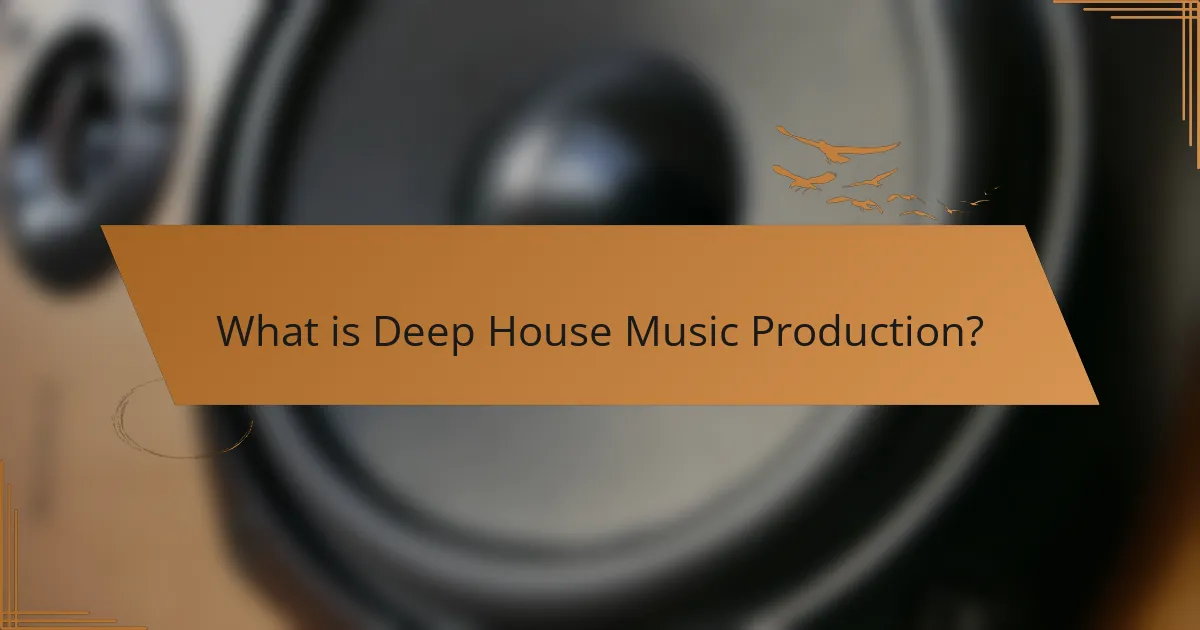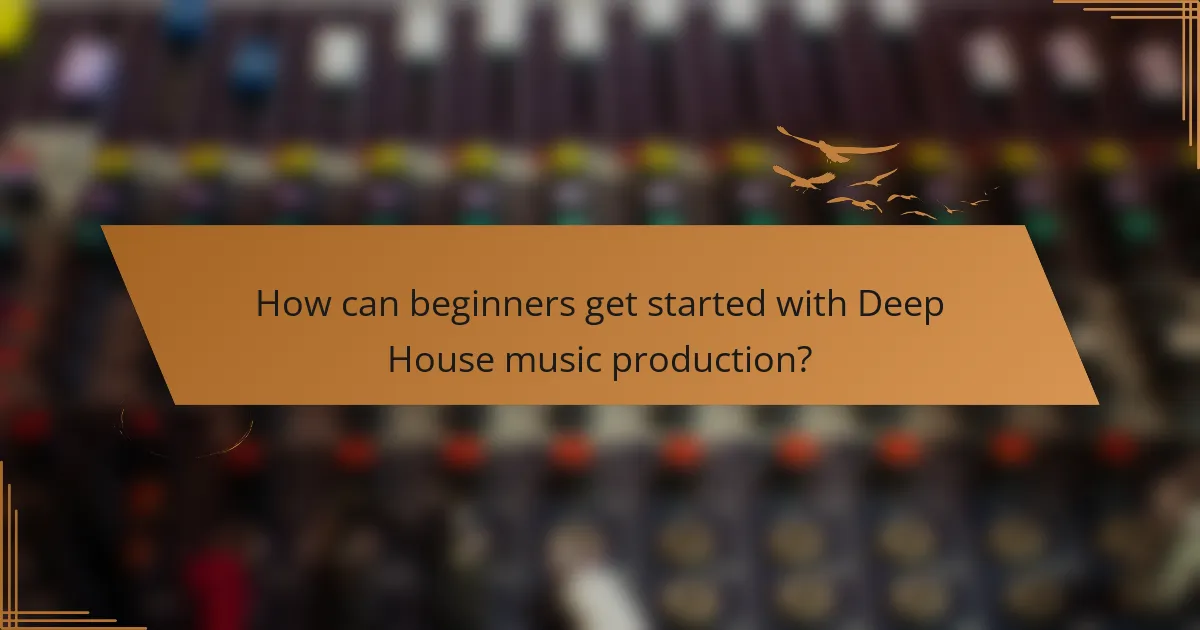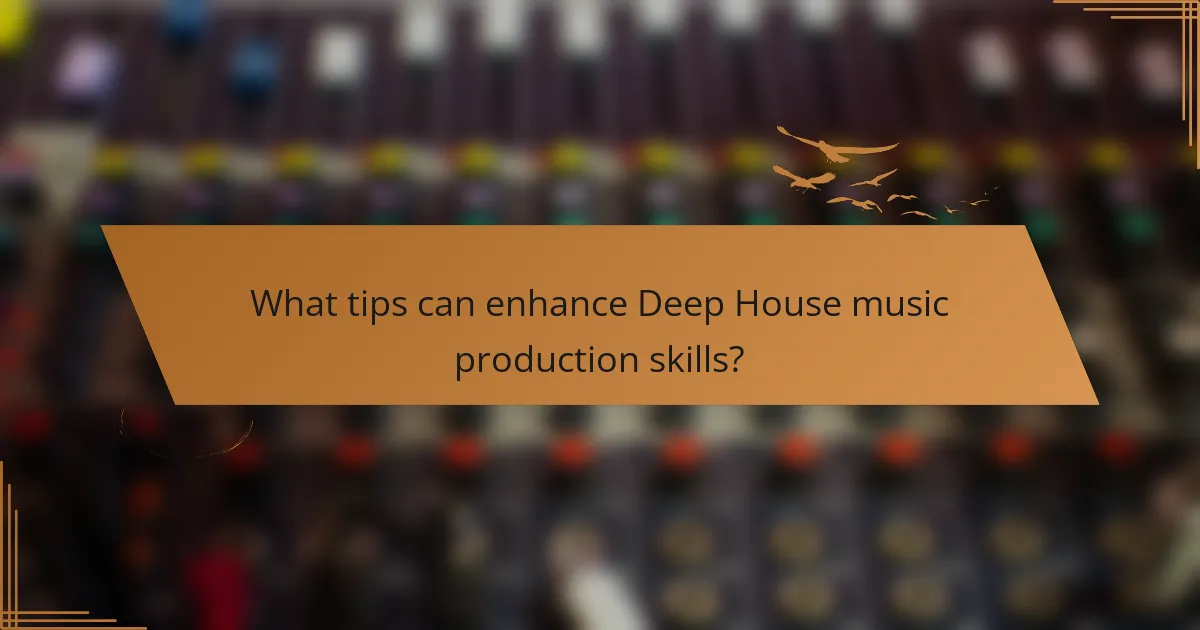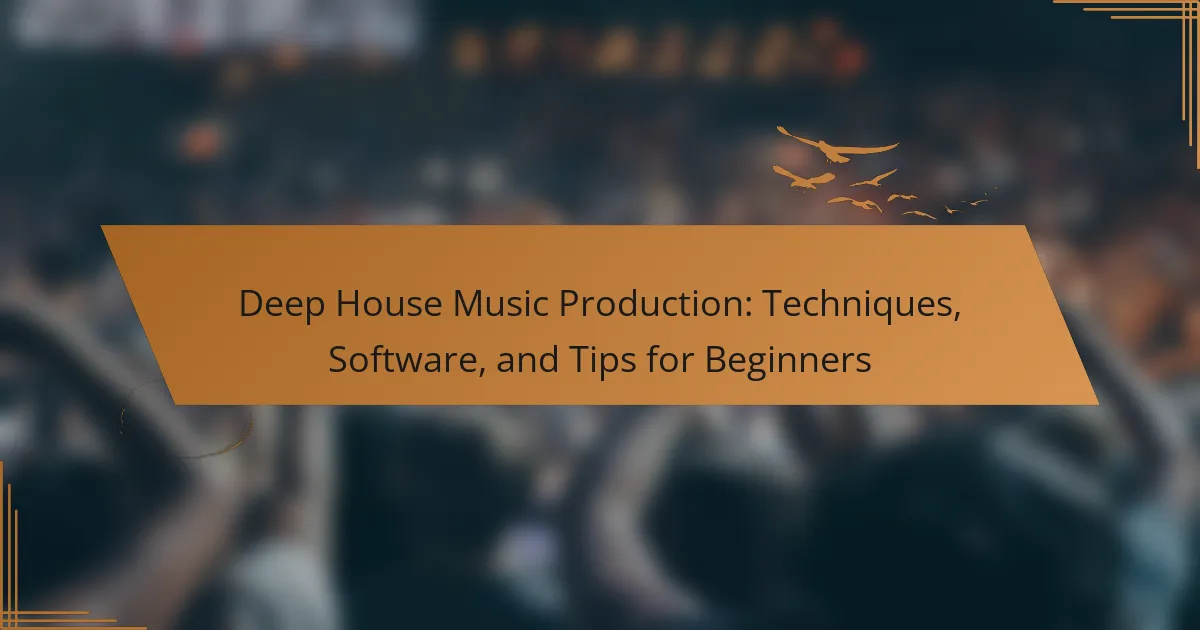Deep House Music Production involves creating deep house music, a subgenre of house music known for its smooth sounds and complex melodies. This process utilizes digital audio workstations (DAWs) like Ableton Live, FL Studio, and Logic Pro, enabling producers to arrange elements such as jazzy chords, atmospheric pads, and deep basslines. The article provides essential guidance for beginners, covering key aspects like choosing the right DAW, understanding deep house characteristics, sound design techniques, and effective beat-making practices. Additionally, it emphasizes the importance of analyzing existing tracks to enhance production skills and creativity within the genre.

What is Deep House Music Production?
Deep House Music Production is the process of creating deep house music, a subgenre of house music characterized by its smooth, soulful sounds and complex melodies. This production involves using various software and techniques to craft tracks that often feature elements like jazzy chords, atmospheric pads, and deep basslines. Producers typically utilize digital audio workstations (DAWs) to arrange and manipulate sounds. Commonly used software includes Ableton Live, FL Studio, and Logic Pro. The genre often incorporates vocal samples and intricate percussion patterns. Deep house music has roots in the 1980s and has evolved significantly, gaining popularity in clubs and festivals worldwide. Its distinct sound is recognized for creating a relaxed yet danceable vibe, appealing to a broad audience.
How does Deep House music differ from other genres?
Deep House music differs from other genres primarily through its distinct sound and characteristics. It features a slower tempo, typically ranging from 120 to 125 BPM. Deep House incorporates complex chords and lush melodies, creating a smooth, atmospheric vibe. The genre often includes soulful vocals and jazz-influenced elements. Unlike other electronic genres, Deep House emphasizes a deep bassline that is both melodic and rhythmic. Its production style often utilizes samples from jazz, soul, and funk music. This blending of styles contributes to its unique sound. Additionally, Deep House tends to focus on creating an immersive listening experience, often designed for extended play in club settings.
What are the defining characteristics of Deep House music?
Deep House music is characterized by its smooth, soulful sound and deep basslines. It typically features slower tempos, usually ranging from 120 to 125 BPM. The genre often incorporates elements of jazz, funk, and soul, creating a rich, melodic atmosphere. Vocals in Deep House are often soft and ethereal, enhancing the emotive quality of the tracks. Additionally, the use of ambient sounds and atmospheric pads is common, adding depth to the overall sound. The genre is known for its extended mixes, allowing for gradual build-ups and transitions. Deep House originated in the 1980s, with influences from Chicago house music, which solidified its unique identity. The genre continues to evolve, blending with other styles while maintaining its core characteristics.
Why is Deep House music popular in today’s music scene?
Deep House music is popular in today’s music scene due to its unique blend of soulful melodies and electronic beats. This genre offers a relaxing yet danceable sound that appeals to a wide audience. Its roots in house music and jazz create a rich auditory experience. The rise of streaming platforms has made Deep House easily accessible to listeners. Additionally, its presence in clubs and festivals boosts its visibility. Collaborations with mainstream artists further enhance its popularity. Data shows that Deep House tracks often dominate playlists on platforms like Spotify. The genre’s emotional depth resonates with listeners seeking a connection through music.
What are the essential techniques for producing Deep House music?
The essential techniques for producing Deep House music include creating a solid drum pattern, using deep basslines, and incorporating atmospheric pads. A solid drum pattern typically features a kick drum on every beat, complemented by snares and hi-hats. Deep basslines are characterized by their warm, subby tones that provide groove. Atmospheric pads add depth and texture to the mix, often using reverb for a spacious feel. Layering sounds enhances richness and complexity. Additionally, using swing in the drum patterns can create a more human feel. Finally, effects like sidechain compression can help the kick drum cut through the mix. These techniques are fundamental for achieving the signature sound of Deep House music.
How do you create a Deep House track structure?
To create a Deep House track structure, start with a typical arrangement consisting of an intro, verse, chorus, bridge, and outro. The intro usually lasts 16 to 32 bars, setting the mood with atmospheric sounds. The verse follows, introducing the main elements like basslines and chords, typically lasting 16 bars. The chorus, or drop, is where the energy peaks, featuring a catchy hook and rhythmic elements. This section often lasts 8 to 16 bars.
A bridge can be added to provide contrast, usually lasting 8 bars, before returning to the chorus. The outro, similar to the intro, gradually fades out, allowing for a smooth transition to the next track.
Additionally, incorporating elements like vocal samples and percussive layers enhances the depth and groove characteristic of Deep House. The use of 4/4 time signature and a tempo range of 120 to 125 BPM is standard in this genre.
What are the key elements to consider in Deep House production?
Key elements to consider in Deep House production include rhythm, basslines, and atmospheric sounds. Rhythm typically features a steady four-on-the-floor beat. Basslines are often deep and groovy, providing a strong foundation. Atmospheric sounds add depth and texture to the track. Chord progressions should be rich and emotive, often using jazzy or soulful influences. Vocals, when included, should be smooth and understated, enhancing the overall vibe. Sound selection is crucial, focusing on warm synths and organic samples. Mixing techniques should emphasize clarity and space, ensuring each element is well-defined. These elements collectively create the signature sound of Deep House music.
What software is best for Deep House music production?
Ableton Live is widely regarded as the best software for Deep House music production. Its flexible workflow allows for intuitive arrangement and manipulation of sounds. Ableton Live features a vast library of samples and instruments ideal for deep house. The software supports various plugins, enhancing sound design capabilities. Its session view is particularly useful for live performances and improvisation. Many professional deep house producers utilize Ableton Live for its efficient MIDI and audio editing features. Research indicates that over 50% of electronic music producers prefer Ableton Live for its user-friendly interface and powerful capabilities.
Which Digital Audio Workstations (DAWs) are recommended for beginners?
Beginner-friendly Digital Audio Workstations (DAWs) include GarageBand, FL Studio, and Ableton Live Lite. GarageBand is free for Mac users and offers an intuitive interface. FL Studio offers a trial version and is known for its user-friendly workflow. Ableton Live Lite is often bundled with hardware and provides essential features for beginners. These DAWs have extensive online tutorials and resources, making them suitable for newcomers to music production.
What plugins are essential for creating Deep House sounds?
Essential plugins for creating Deep House sounds include synthesizers, drum machines, and effects units. Popular synthesizers like Serum and Massive provide rich, textured sounds. Drum machines such as Battery or Superior Drummer offer realistic drum samples. Reverb and delay plugins, like Valhalla Room and EchoBoy, enhance spatial depth. Additionally, EQ and compression plugins, such as FabFilter Pro-Q and Waves SSL G-Master, help shape the mix. These tools are widely used in the Deep House genre for their versatility and sound quality.

How can beginners get started with Deep House music production?
Beginners can get started with Deep House music production by choosing the right digital audio workstation (DAW). Popular DAWs for this genre include Ableton Live, FL Studio, and Logic Pro. These platforms provide essential tools for music creation, including MIDI mapping, audio editing, and built-in effects.
Next, beginners should familiarize themselves with Deep House characteristics. This genre typically features smooth basslines, soulful vocals, and atmospheric pads. Understanding these elements is crucial for creating authentic tracks.
Additionally, beginners should learn about sound design. Synthesizers like Serum and Massive are commonly used in Deep House. They allow users to create lush sounds and unique textures.
Practicing beat-making is also important. Beginners should experiment with drum patterns, focusing on kick, snare, and hi-hat placements. A steady four-on-the-floor beat is a hallmark of Deep House.
Finally, listening to existing Deep House tracks can provide inspiration. Analyzing the structure and elements of popular songs helps in understanding the genre’s nuances. By following these steps, beginners can effectively start their journey in Deep House music production.
What are the first steps for a beginner in Deep House music production?
Beginner steps in Deep House music production include selecting a Digital Audio Workstation (DAW). Popular DAWs for this genre are Ableton Live and FL Studio. Next, familiarize yourself with the DAW’s interface and features. Understanding basic music theory helps in creating melodies and chords. Start experimenting with drum patterns typical of Deep House. Utilize samples and synths to craft unique sounds. Learn about mixing techniques for balance and clarity. Finally, practice regularly to develop your skills and style.
How can you set up your home studio for Deep House production?
To set up your home studio for Deep House production, start with a dedicated space. This area should be quiet and free from distractions. Invest in a quality digital audio workstation (DAW). Popular choices include Ableton Live and FL Studio. Next, acquire studio monitors for accurate sound reproduction. Look for models that provide a flat frequency response. Include a MIDI controller to facilitate music creation. Choose one that fits your workflow, such as a keyboard or pad controller. Acoustic treatment is essential to minimize sound reflections. Use foam panels and bass traps to improve sound quality. Finally, ensure you have a reliable audio interface for connecting your equipment. This setup will enable effective Deep House music production.
What basic skills should a beginner focus on developing?
Beginners in deep house music production should focus on developing skills in music theory, software proficiency, sound design, and arrangement. Music theory helps in understanding chords, scales, and rhythms, which are essential for creating melodies and harmonies. Proficiency in digital audio workstations (DAWs) is crucial for navigating production software effectively. Sound design skills enable beginners to create unique sounds using synthesizers and samples. Lastly, arrangement skills help in structuring tracks to maintain listener interest and flow. These foundational skills are supported by the need for a solid understanding of the elements that make deep house music engaging and cohesive.
What common mistakes should beginners avoid in Deep House production?
Beginners in Deep House production should avoid several common mistakes. One mistake is neglecting sound selection. Quality samples and synths are essential for a polished sound. Another mistake is improper mixing. Balance and clarity are crucial for deep house tracks. Overusing effects is also common. Effects should enhance the track, not overwhelm it. Additionally, beginners often overlook arrangement. A well-structured arrangement keeps listeners engaged. Lack of understanding of tempo and rhythm can hinder production. Deep house typically ranges from 120 to 125 BPM. Finally, beginners may skip mastering. Proper mastering ensures the track sounds professional across all playback systems.
How can poor mixing affect the quality of a Deep House track?
Poor mixing can significantly degrade the quality of a Deep House track. It can lead to an unbalanced sound where certain elements overpower others. This imbalance affects the clarity and overall listening experience. Frequencies may clash, creating muddiness in the mix. Low-end frequencies can overshadow vocals and melodic elements. This results in a lack of definition and separation between sounds. Additionally, poor mixing can diminish the emotional impact of the track. Listeners may find it less engaging and harder to connect with the music. Overall, effective mixing is essential for producing a polished and professional Deep House track.
What are the pitfalls of using too many effects in production?
Using too many effects in production can lead to a cluttered sound. Excessive effects can mask the core elements of a track. This results in a loss of clarity and focus. Listeners may find it difficult to identify the main melody or rhythm. Additionally, over-processing can create phase issues. These issues can cause unwanted frequency cancellations. Ultimately, this diminishes the overall quality of the mix. A clean mix is essential for effective deep house music production.

What tips can enhance Deep House music production skills?
To enhance Deep House music production skills, focus on mastering sound design. Understanding synthesizers and their parameters is crucial. Experiment with different waveforms to create unique sounds. Layering sounds can add depth and richness to your tracks. Utilize effects such as reverb and delay to create space and atmosphere. Pay attention to the arrangement of your tracks for better flow. Use a variety of drum patterns to maintain listener interest. Finally, regularly analyze tracks from established Deep House artists to learn production techniques.
How can you improve your sound design for Deep House music?
To improve your sound design for Deep House music, focus on layering sounds effectively. Layering involves combining multiple sounds to create a richer texture. Use a mix of synths, samples, and effects to achieve depth. Experiment with different sound frequencies to enhance clarity. Employ sidechain compression to create a pumping effect, common in Deep House. Utilize reverb and delay for spatial effects, adding ambiance to your tracks. Pay attention to the low-end frequencies for a solid bass foundation. Lastly, analyze successful Deep House tracks for inspiration and techniques. This approach will refine your sound design skills and elevate your music production.
What techniques can help in achieving a professional mix?
Achieving a professional mix involves several key techniques. First, use equalization (EQ) to carve out space for each element. This helps prevent frequency clashes. Second, apply compression to control dynamic range and maintain consistency in levels. Third, utilize panning to create a sense of width in the mix. This enhances spatial perception. Fourth, employ reverb and delay to add depth and atmosphere. These effects can make the mix feel more cohesive. Fifth, use reference tracks to compare your mix against professional standards. This ensures your mix meets industry expectations. Finally, perform careful volume balancing for all elements. This is crucial for a polished final product.
How can collaboration with other artists benefit your production?
Collaboration with other artists can significantly enhance your production. It fosters creativity by combining diverse ideas and styles. This synergy can lead to innovative sounds and unique tracks. Collaborators can provide valuable feedback, helping to refine your work. They may also introduce you to new techniques and tools. Networking through collaboration can expand your audience reach. Statistics show that collaborative projects often outperform solo efforts in streaming platforms. For example, tracks featuring multiple artists tend to receive more plays and shares.
What resources are available for learning Deep House music production?
Online courses are available for learning Deep House music production. Platforms like Udemy and Coursera offer structured lessons. YouTube features numerous tutorials on specific techniques and software. Websites like Splice provide sample packs and production tools. Forums such as Gearslutz foster community learning and advice. Books on music production cover foundational concepts and advanced techniques. Software manuals for DAWs like Ableton Live and FL Studio offer in-depth guidance. Additionally, podcasts and blogs focus on industry trends and tips for producers.
Which online courses or tutorials are recommended for beginners?
Recommended online courses for beginners in deep house music production include “Music Production in Logic Pro X” on Udemy and “Electronic Music Production” on Coursera. These courses cover essential techniques and software used in deep house music. They provide step-by-step tutorials suitable for novices. Additionally, “Ableton Live 11 Essential Training” on LinkedIn Learning is highly regarded. It focuses on the software commonly used in deep house production. Each course includes practical exercises and projects to reinforce learning. These resources are well-reviewed and frequently updated to reflect industry standards.
What role do communities and forums play in learning Deep House production?
Communities and forums play a crucial role in learning Deep House production. They provide a platform for sharing knowledge and experiences among producers. Members can ask questions and receive feedback on their work. This interaction fosters a collaborative learning environment. Additionally, forums often host tutorials and resources specific to Deep House techniques. Engaging with experienced producers can accelerate skill development. Many successful producers credit online communities for their growth. Active participation can lead to networking opportunities and collaborations. Overall, these platforms enhance the learning process through shared expertise.
What are the best practices for producing Deep House music effectively?
To produce Deep House music effectively, focus on creating a solid groove. Utilize a strong bassline that drives the rhythm. Incorporate smooth chords and atmospheric pads for depth. Layer percussion elements to enhance the groove’s complexity. Use high-quality samples and synths to achieve a polished sound. Pay attention to mixing techniques for clarity and balance. Utilize sidechain compression to create a pumping effect. Finally, ensure your arrangement maintains listener interest throughout the track.
Deep House Music Production is the process of creating deep house music, a subgenre of house music known for its smooth, soulful sounds and complex melodies. This article covers essential techniques, recommended software, and tips for beginners, including key elements such as rhythm, basslines, and atmospheric sounds. It also discusses the importance of sound design, mixing techniques, and the role of collaboration in enhancing production skills. Resources for learning Deep House production, including online courses and community forums, are highlighted to support aspiring producers in developing their craft.
